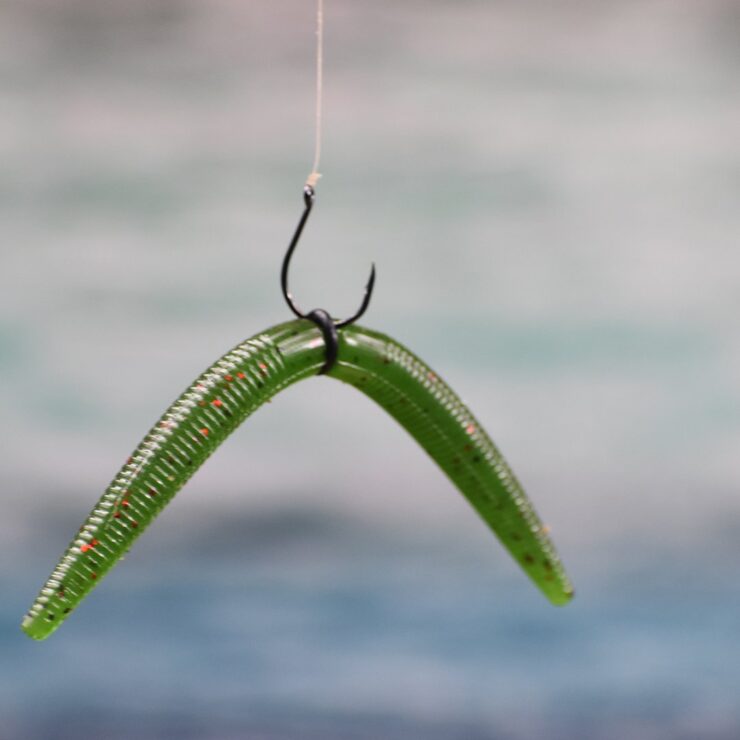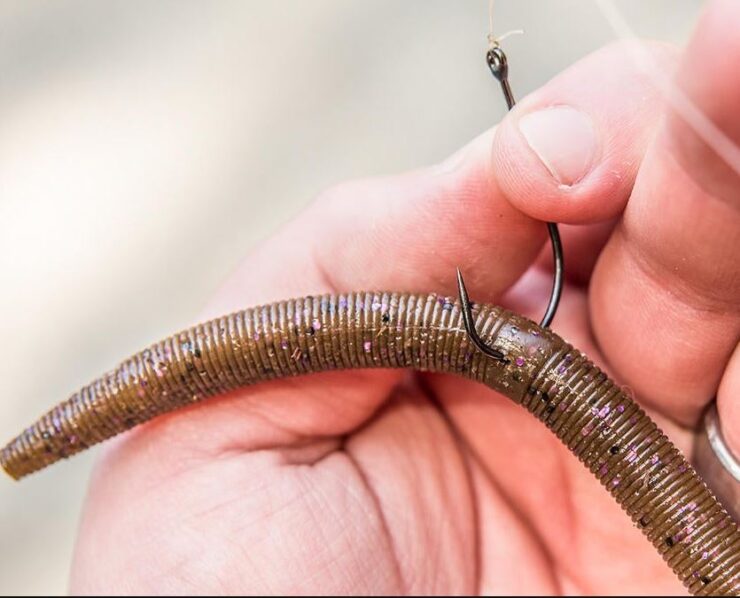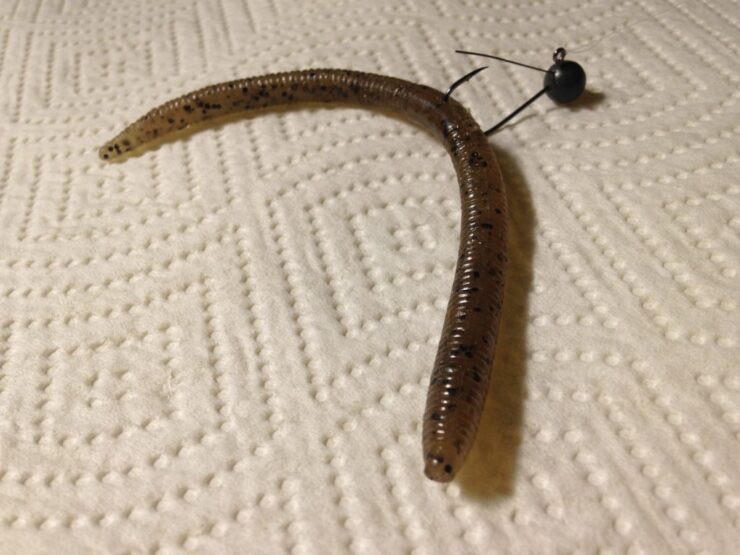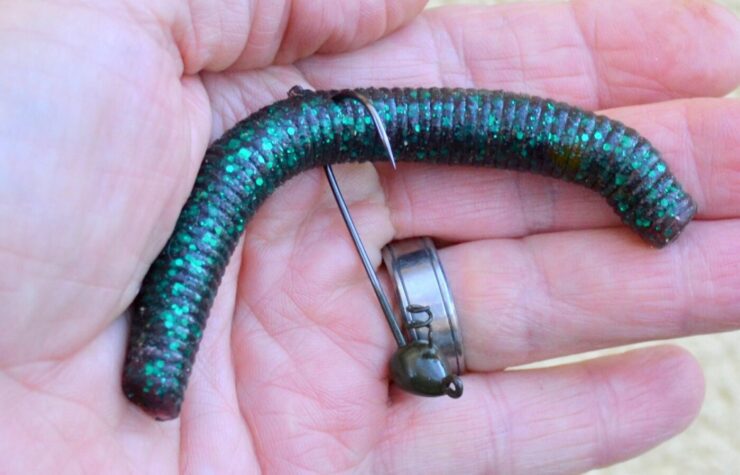Wacky worms are one of the most popular lures in bass fishing. They are cheap, easy to use, and produce great results.
Wacky worms are an effective type of fishing lure. They are made from soft plastic, have an asymmetrical shape with a paddle tail that has slits running down the length of it. This causes the bait to flutter as it falls through the water column, furthering its resemblance to a real organism.
Bass have poor eyesight which makes this an even more effective imitation tactic. Another reason wacky worms are so effective is the pliable texture that allows them to wiggle and move naturally, which makes them appear alive and appeal to a bass’s appetite because they search for live prey in their habitat.
Table of Contents
ToggleWhy are Wacky Worms So Good?

So what makes wacky worms so effective? A lot of things actually. Their pliable texture allows them to wiggle and move naturally, making them appear alive. This is a great way to appeal to a bass’s appetite because they search for live prey in their habitat. The plastic used is also soft enough that the worm can be pulled out of vegetation easily.
In addition, wacky worms have an asymmetrical shape with a paddle tail that has slits running down the length of it. This causes the bait to flutter as it falls through the water column, furthering its resemblance to a real organism. Bass have poor eyesight which makes this an even more effective imitation tactic.
For added attraction, you can add a scent such as Power Bait®’s “Shake ‘n’ Bubbles®” scent to the worm. This will increase the bass’s sense of smell and make them more likely to bite.
How To Fish With The Wacky Worm

Setting up a Wacky Worm could not be simpler. All you require is a hook and a worm. It’s that simple.
To hook the hook Some people use the standard worm hook however, I would highly recommend using an Octopus hook. The smaller shank will not niggle on underbrush and moss. They also have a broad hook-gap for stabs at Ole Bucketmouth’s lips.
Although not totally weed-free, Gamakatstu and a few other companies offer Octopus hooks that come with weed-guards. They are ideal to use for Wacky Worms. You can also create your own by using tie flies simply by attaching an extra 50or more lb. monofilament to the hook eye. Then reduce the ends until they are just over the hook’s point. To make them more robust, instead of running your hook over the worm you can slip on an O-ring made of plastic, and then run the hook through it. If you don’t, the majority time the bass will tear the worm and makes it inedible for further fishing such as this. The O-ring can help you catch multiple bass on one worm.
How To Cast Wacky Worms
When you cast your wacky worm, reel it out about ten feet until it hits the bottom, then pause for a few seconds so that it can sink. Then crank up your handle three-quarters of a turn or an inch and let it fall back down to the bottom; this is called “drop-shotting.” Repeat this process as many times as possible, pausing between each drop. This causes the soft plastic tail to move naturally and imitate a fleeing baitfish (sluggish bass often ambush their prey).
Once you feel something tugging on your line, give your rod tip a sharp upward jerk upwards and hook the fish! Bass often attack prey with a single chomp and immediately retreat to cover to eat it, so if you can set your hook fast enough, you may snag an impressive catch.
If you’re using live bait (which is recommended), try using a bobber stop instead of clipping your worm directly on the line. When hooked, bass tends to thrash around at the surface which causes them to die from asphyxiation if they are left in their natural habitat. If you attach a bobber stop between your weight and hook, the frantic movements will cause the worm/bobber combo to rise up slightly above water level and allow oxygen into its gills. Your wacky worm’s tail may still flutter down to the bottom but at least your catch will still be alive when you bring it to shore!
This tactic allows you to save money because you can use the same live bait multiple times for several days. You could even rig two or three worms on one hook if you think there are too many bass around and need to increase your chances of catching something.
Bass are known for their voracious appetites so any worm that wiggles is likely to attract them in a big way. Wacky worms are one of my favorite lures because they’re cheap, customizable, and easy to use—the perfect recipe for an effective fishing trip.
Who Invented The Wacky Worm?

No one knows for sure! This method is often attributed to the late Bassmaster Elite Series pro, Eric “The Eel” Johnson. He used these worms on his competition trail in 2013; not only did he win the tournament, but bass fisherman everywhere got hooked on this new way to catch fish. Nowadays wacky worms are becoming increasingly popular because of their effectiveness and simplicity.
Most experts agree that it’s better to be safe than sorry when using a live bait worm, especially if you’re fishing away from a populated area where there will be lots of other fishermen around. It’s always best to use an older worm that looks almost dead or a snag-free type like Berkley® Gulp!® Wriggling Grub. This will increase the chances that your bait won’t be bothered by competitors’ hooks or sharp teeth like larger fish’s.
Adelaide Gentry, a seasoned kayaking enthusiast and expert, is the driving force behind KayakPaddling.net. With over a decade of experience navigating the world’s most challenging waterways, Adelaide combines her passion for adventure with a deep knowledge of kayaking to provide insightful and practical guidance for paddlers of all levels.
Related Posts:
- 12 Best Fishing Lures Ever 2025 - Baits That…
- Heavy Duty Fishing: 11 Best Rods And Reels For Big Fish 2025
- 10 Best Saltwater Fishing Boats - Ultimate Angling Adventure
- 9 Best Backpacking Fishing Rods 2025 - Lightweight…
- 12 Best Motorized Kayak 2025 - Start Your Aquatic Adventure!
- 10 Best Inflatable Kayak 2025 - Rivers, Lakes & Open Seas












